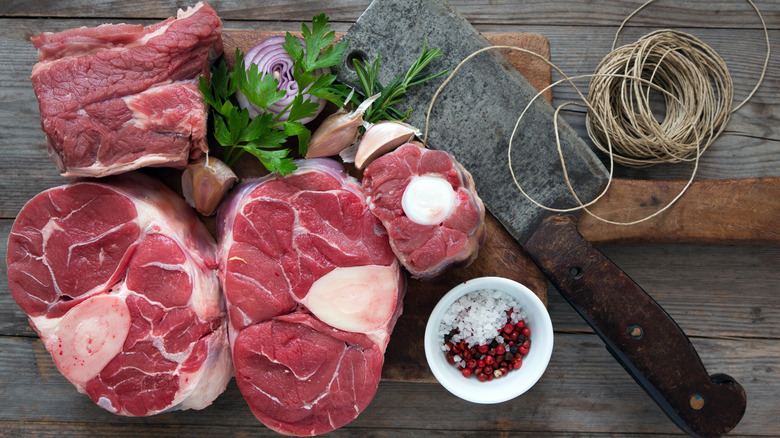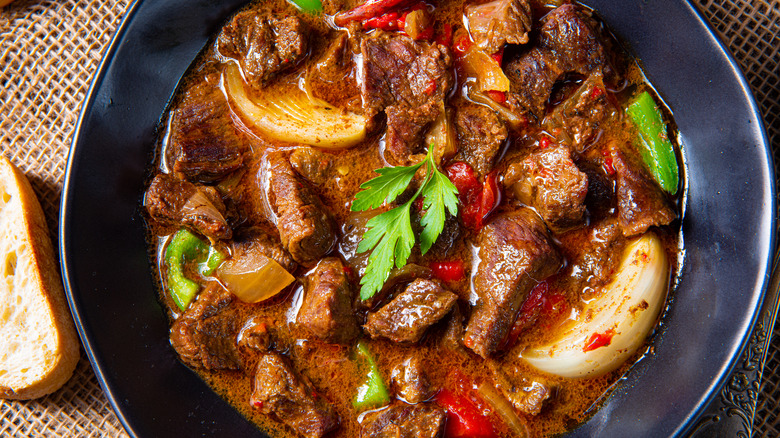The Differences Between Meat For Stewing And Grilling
Heading to the butcher shop — or the butcher's counter of your favorite grocery store — can be intimidating, especially if you're planning on trying something new. And honestly, that's just one great reason that you should really consider buying meat from your local butcher: They have the expertise that's needed to answer any and all of your questions. That includes what sets different cuts of meat apart from each other and what's best for specific uses, but let's give you some background on some of the key differences between the meat you're going to be picking up for slow-cooking in a delicious stew, and something you might opt to grill.
At the heart of the matter is how long it's going to take for meat to cook to a state that it's tender. Let's take ribeye, which is generally thought to be one of the best steaks for grilling. That has it all, including the right amount of fat and marbling that will render into the meat and help make it tender and juicy pretty quickly. Other cuts — like round and brisket — will come off that grill incredibly tough, but why?
In a nutshell, the harder a muscle has to work while the cow's alive, the tougher the meat is going to be. Tougher meat means it's going to take more time and more work to transform it into something tender, but at the same time, it's worth the extra effort. There's nothing quite like a delicious, warm-you-from-the-inside beef and Guinness stew on a chilly evening, and perfection like that takes time.
Here's why some cuts of meat are tough and some aren't
If you look at where different cuts of meat come from on a cow's body, you'll notice that those that are perfect for grilling — like the rib, sirloin, and the filet — come from areas that don't really get much of a workout. On the other hand, cuts that are typically used for stewing (and braising) come from areas that work really, really hard. Brisket comes from the shoulder and shanks come from the legs, for example, so it makes sense that those are going to be tougher, leaner cuts.
Interestingly, there's one cut of meat that might seem like it would be the most tender of all, but it's actually really tough. Those are beef cheeks: They make for delicious stew meat and need to be cooked for a long time. But why? Cows are ruminates, which means they can spend as much as 40% of their day chewing and those facial muscles get surprisingly tough.
Tough cuts are what get labeled as stew meat, but it's also worth noting that if you pick up something that's labeled as a generic "stew meat," it's entirely possible you're getting very different cuts of meat all packaged together. Those different cuts may cook slightly differently, which means you may want to ask your friendly neighborhood butcher for specific cuts.
Slow-cooking turns tough meat tender by a long process
When you throw that ribeye on the grill, you're probably going to be cooking it fairly quickly at a high heat. That's going to allow you to get a nice sear on the outside, and keeping an eye on the internal temperature means you'll be cooking it to — for example — between 130 and 135 Fahrenheit for a medium rare steak. That ribeye has fatty marbling that melts quickly and allows it to come off that grill tender, but there's more that goes into cooking tougher cuts of stew meat.
Tough cuts don't have as much fatty marbling, and instead, it takes a longer process to break down connective tissues like collagen. That collagen is what makes stew meat bad for grilling, but great for slow-cooking. How? As that slowly dissolves, it turns into gelatin — and that's what gives dishes like your classic slow cooker beef stew that soft, creamy mouthfeel and unparalleled texture.
There's one more interesting thing at work here. Everyone knows that some things — like a beef curry or stew — are better on the second day, right? There's a theory that this is because of what happens to the collagen. On the initial cook, it breaks down into gelatin and all that hearty goodness, but when you put it in the fridge overnight, that gelatin re-congeals. The next time you go to cook it, it dissolves into silky deliciousness immediately — which is why it just tastes so much better. Neat, right?


